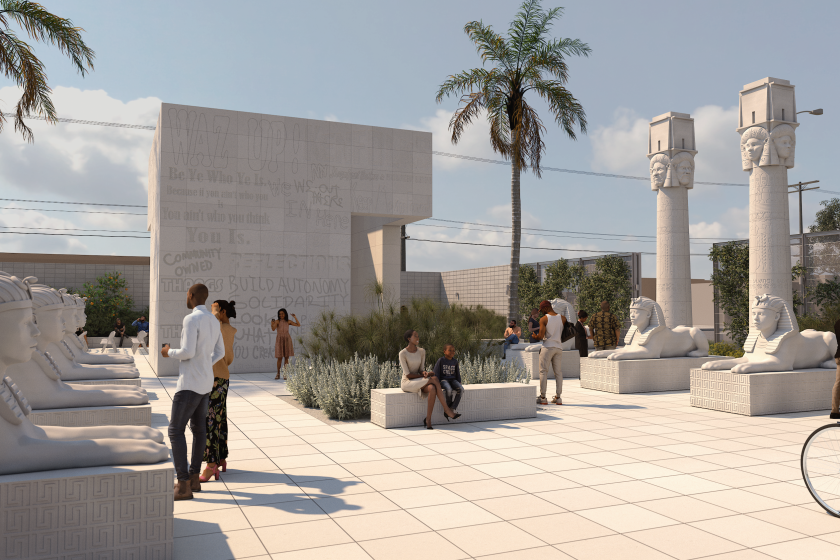AROUND THE GALLERIES
Erin Cosgrove’s pseudo-historical, multimedia epic “What Manner of Person Art Thou?” turns a sharp eye on matters of faith, revelation and the quasi-religious longings of secular society. By turns comic and bloody, silly and harrowing, the project, whose various incarnations span the UCLA Hammer Museum and the Carl Berg Gallery, is impressive in its breadth and astute in its satire.
The story, told most directly in a 65-minute animated video at the Hammer, revolves around the figures of Elijah Yoder and Enoch Troyer, sole surviving members of an isolated Christian fundamentalist sect that’s been decimated by a mysterious epidemic. Aiming to replenish their numbers and rebuild their community, the two set off in search of a handful of previous defectors.
It is a strange and increasingly psychedelic journey, rendered in a stiff, rudimentary animation style that falls somewhere between Monty Python, “Scooby-Doo,” “South Park” and those hellfire-and-brimstone comic books one finds littering the parking lots of strip malls.
The motley cast of characters that Yoder and Troyer encounter -- a brooding circle of “D&D;”-style gamers; a cultural studies professor who puts even the vitriolic Yoder to sleep; a quasi-Scientologist self-help practitioner digging for latent strains of homosexual longing; the two buxom stars of a reality television show titled “Who Wants to Marry Siamese Twins?”; a corrupt corporate executive; and a failure of a would-be whistle-blower, among others -- present a sardonic cross-section of contemporary America.
The heterogeneity of secular culture, however, proves a tad overwhelming for our righteous protagonists, who believe themselves to be in direct communication with God and thus endowed in every reaction and compulsion with a sense of divine authority. That most of these compulsions tend to arise with scythe in hand makes this also a very violent journey. Heads fly, limbs are severed, blood spews in every direction, as this team of would-be evangelicals meets difference with intolerance and basically slaughters all hope for the resurrection of the community.
The video itself is only the beginning -- the primary text from which a slew of “interpretive” materials has evolved. These are the works are on view at Carl Berg Gallery: a 15-foot scroll depicting another version of Yoder and Troyer’s story, “starting from the beginning of time and ending in apocalypse”; a photocopied pamphlet detailing the “discovery” of the scroll in the possession of a person named Nigel Hertson, a recently deceased recluse and role-playing game enthusiast who claimed to have received the tale from a mysterious figure named “M.”; a seven-minute, filmstrip-style pseudo-documentary video speculating (often erroneously) on the meaning of the scroll’s enigmatic imagery; and a series of paintings on clear film resembling the pages of illuminated manuscripts, supposedly executed by Hertson.
The strength of Cosgrove’s satire is that it cuts in all directions, skewering the folly of the secular as thoroughly as the presumption of the righteous, in a manner refreshingly devoid of the knee-jerk liberal scorn of faith. There are no heroes here, no martyrs and no true prophets, nor are there any easy paths to redemption. What Cosgrove does scorn, it seems, is ignorance; what she prophesies are the consequences of the insufficiently considered action (and, by extension, life), whether that of the religious zealot, the cultural critic or the corporate executive.
--
UCLA Hammer Museum, 10899 Wilshire Blvd., L.A., (310) 443-7000, through March 15. Closed Mondays. www .hammer.ucla.edu
Carl Berg Gallery, 6018 Wilshire Blvd., L.A., (323) 931-6060, through March 14. Closed Sundays and Mondays. www.carl berggallery.com
--
Tipping toward abstraction
Tomory Dodge has the advantage of being a painter who clearly loves paint, which lends most everything he does a base level of luscious materiality. The question that follows -- and that seems unresolved at this point -- is what exactly he should be doing with it.
In five solo-show-studded years since graduating from CalArts, he’s become known for tipping between representation (largely landscape-oriented) and a highly gestural abstraction, drawing inevitable comparisons to Gerhard Richter and Joan Mitchell, among others. Lately he’s been tipping decidedly toward abstraction.
There are about seven large canvases (6 to 7 feet across) and three smaller studies in his current show at ACME. Most are predominantly black, with intermittent touches of sky blue, green and pink. The only trace of representation is the occasional suggestion of a night sky lurking behind the thick clouds of brush strokes that make up the bulk of each composition.
The effect is dense, claustrophobic and vaguely oppressive. The frenetic patchwork of strokes, gathered like bits of lint on a screen across a vent, keeps the viewer pinned to the surface of the canvas, while the occasional, teasing hints of sky suggest another, more spacious realm beyond. It is clearly a deliberate choice, but to what purpose isn’t clear. As engaging, even engrossing, as the details of Dodge’s surfaces can be, the enterprise as a whole feels rather muddled.
One has the sense of the artist confronting the enormity of the universe, making these marks by way of both declaration and self-assurance: I am here, I am here, I am here -- the fundamental implication of the gesture since the birth of painting itself.
To which one is compelled to respond: Yes, I see that. And?
--
ACME, 6150 Wilshire Blvd., L.A., (323) 857 5942, through March 14. Closed Sundays and Mondays. www.acmelos angeles.com
--
Visualizing nationalism
Renee Petropoulos puts a canny spin on issues of global conflict and cooperation in her recent paintings at Rosamund Felsen Gallery.
Each piece is roughly 2 feet across, oil on beige linen, and composed in colors drawn from the flags of two particular nations, linked by some determined but unspecified relationship, typically relating, one gathers, to an unusually tenuous balance of power. The pairing is evident in the title: “From France to Algeria,” “From England to Sudan,” “From Angola to Albania,” “From Iraq to Korea,” “From Kenya to Jamaica” and so on.
The spin lies in the sleek, Modernist treatment Petropoulos gives to these none-too-subtle palettes. The compositions are geometric in nature, but finely wrought and wonderfully delicate. Some patterns span the entire canvas, creating a flat, blocky, textile effect; others float across the raw linen in medallion-like squares or stripes.
They’re lovely paintings by any artistic measure, and that loveliness comes as a clever, poignant indictment of the brute force such colors are regularly employed to corroborate or justify.
Also included in the show are a number of sound pieces, accessible through a provided headset, that follow the same formula, overlaying two particular national anthems. The result, in nearly every case, is a cacophonous mess in which the intrinsic aggression of the nationalistic impulse -- the righteous cadences and plodding, militaristic rhythms -- becomes the most eerily salient elements.
--
Rosamund Felsen Gallery, 252 Michigan Ave., B4, Santa Monica, (310) 828-8488, through March 7. Closed Sundays and Mondays. www.rosamund felsen.com
--
Glass, glittering in its fragility
Katherine Gray works in a medium -- glass -- that rarely takes center stage in a contemporary art gallery not already given over to craft or design.
“It’s a Very Deadly Weapon to Know What You’re Doing,” her first solo show at Acuna-Hansen Gallery, makes this seem an unfortunate fact. It is, as she notes in a statement on the show, a “devastatingly beautiful” material with as rich an array of conceptual implications as any of the other historically craft-oriented media that have fed into fine art over the course of the last few decades.
The centerpiece of the show, “Forest Glass,” is an installation consisting of a pair of free-standing, clear acrylic shelving units, each roughly 9 feet tall and around the breadth of a coffee table, loaded with hundreds of mismatched thrift store glasses.
At first glance, the towers are all dazzle, sparkling and glittering in the light, giddily precarious in their fragility. Step back, however, and you’ll see that the glasses are arranged by color -- clear, brown and green -- in such a way as to form the shape of a tree.
The work’s title refers to a type of Medieval Northern European glassware that was characterized by its green and brown tints, and that relied on -- and depleted -- local forests to fuel the furnaces in the factories. The piece, which is designated “in progress” (another, presumably larger version will appear at the Chrysler Museum in Virginia later this spring), draws on present-day notions of reuse and recycling to posit a clever sort of reforestation.
Several smaller, blown-glass works in the back room make a lovely addition, emphasizing the broad potential of the medium while also showcasing Gray’s very considerable skills.
--
Acuna-Hansen Gallery, 427 Bernard St., L.A., (323) 441-1624, through March 21. Closed Sundays through Tuesdays. www.ahgallery.com
--
More to Read
The biggest entertainment stories
Get our big stories about Hollywood, film, television, music, arts, culture and more right in your inbox as soon as they publish.
You may occasionally receive promotional content from the Los Angeles Times.






